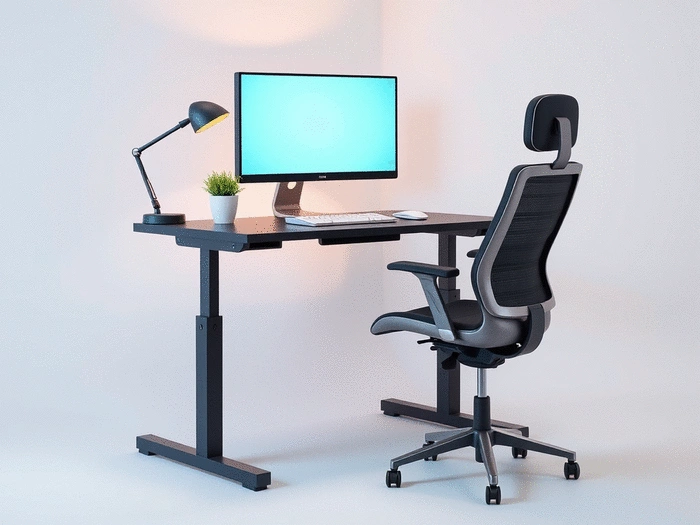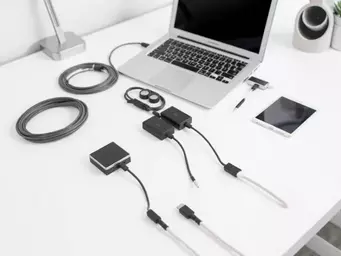Optimal Desk Height
Elbows should rest at a 90-degree angle.
Subscribe to Tidy Workspace Lab for expert tips and updates on creating a clutter-free workspace.
Posted on: 2025-07-16
By: Maya J. Ellison
Have you ever noticed how a small change in your workspace could lead to a significant impact on your comfort and productivity? Embracing ergonomic principles is essential for maintaining good posture and overall well-being while working. Discover how simple adjustments can transform your daily experience at your desk.
Understanding the essential elements that contribute to an ergonomic workspace can enhance comfort and productivity. Below is a visual representation of these key components.
Elbows should rest at a 90-degree angle.
A supportive chair is crucial for your back.
Screen should be at eye level to avoid neck strain.
Keep these close to avoid reaching too far.
Enhances comfort and supports proper posture.
Helps maintain neutral wrist positioning.
👉 Need the big picture? Read the Complete Setup ideas & Inspiration Guide.
Have you ever found yourself slouched over your desk, feeling aches and pains by the end of the day? You're not alone! Understanding how to create an ergonomic desk setup can significantly improve your posture and overall comfort while working. At Tidy Workspace Lab, I believe that a well-organized and ergonomically sound workspace is key to boosting productivity and well-being.
Did you know that a well-organized workspace can s
Are you ready to transform your workspace into a h
Let’s take a closer look at the importance of ergonomics in the workplace and how it can transform your daily experience. By making a few adjustments, you can create a workspace that supports your body and enhances your focus, allowing your creativity to flow freely.
Ergonomics is all about designing your workspace to fit your needs, rather than forcing your body into uncomfortable positions. When your workstation is well-designed, it can help reduce strain and prevent long-term injuries. Here are some key reasons why ergonomics matter:
By valuing ergonomics, you're taking a step towards a healthier work-life. Whether you're working from a home office or at a corporate desk, an ergonomic setup is essential for your well-being!
Your posture plays a huge role in your overall health. Poor posture can lead to discomfort, fatigue, and even chronic pain. Embracing an ergonomic desk setup helps support proper alignment, allowing your body to function as it should. Think of it this way—when your body is aligned, it's easier to focus on your tasks rather than on aches and pains!
Incorporating ergonomic principles can also lead to better breathing and circulation. Imagine being able to breathe deeply and move without restriction—this is what an ergonomic workspace can do for you. By setting up your desk with posture in mind, you'll feel the difference in your workday.
The advantages of a well-planned ergonomic workspace go beyond just comfort. Here are some amazing benefits of adopting an ergonomic desk setup:
Investing time in creating an ergonomic workspace is one of the best decisions you can make for your health and productivity. At Tidy Workspace Lab, I am passionate about sharing tips and tricks to help you build a workspace that supports both your comfort and your ambitions.
To create the perfect ergonomic desk setup, you'll need to focus on several key components that come together to form a cohesive workspace. With a little attention to detail, you can achieve a setup that not only looks great but feels great too!
By focusing on these components, you can create an ergonomic workstation tailored to your unique needs. Remember, every small adjustment counts toward a healthier work experience!
Did you know? Incorporating small movement breaks throughout your workday can greatly enhance your overall productivity and well-being. Try setting a timer for every hour to remind yourself to stand up, stretch, or even take a short walk. This simple practice not only helps to relieve muscle tension but also refreshes your mind, making it easier to focus when you return to your tasks. Your body and mind will thank you!
Ergonomics is the practice of designing workspaces to fit the needs of the people using them. It's important because it reduces strain, prevents injuries, improves comfort, enhances focus, and increases productivity.
The key components include optimal desk height (elbows at a 90-degree angle), a supportive chair, proper monitor placement (at eye level), correct keyboard and mouse positioning (close to the body), footrests, and keyboard trays.
Technology can help through wearable devices that remind you to sit up straight, posture-correcting apps that alert you when you're slouching, and software that prompts you to take regular breaks and stretch.
Simple exercises include neck stretches, shoulder rolls, and wrist stretches. Incorporating these into your routine can reduce strain and enhance overall comfort.
For remote work, invest in adjustable furniture, use proper lighting, and organize your space. In shared workspaces, bring your own ergonomic accessories, communicate with colleagues about adjustments, and keep your area tidy.
Embracing technology in your workspace can significantly enhance your ergonomic setup! At Tidy Workspace Lab, we believe that the right tools can make a huge difference in how you feel while working. From monitoring your posture to encouraging movement, technology offers a range of options to support your health and productivity.
Keeping track of your posture throughout the day doesn't have to be complicated. Today, various apps and gadgets can give you real-time feedback on your sitting habits. Here are some tools to consider:
Wearable devices have become my personal favorites for keeping posture in check! These gadgets can vibrate or send notifications when you need to straighten up. Plus, they often track your movement, helping you stay aware of how much you're sitting versus standing.
Many wearables even sync with your smartphone to provide insights into your daily activity levels. This feedback is crucial for making gradual changes that enhance your posture and overall well-being. Imagine sitting down and realizing your posture has improved simply because you have a little reminder on your wrist!
There’s a world of software out there that can help you cultivate better work habits. These tools often include reminders to get up, stretch, or even perform simple exercises right at your desk. Here are some popular options:
Now that you've set up your ergonomic tools, it’s time to incorporate some daily exercises! Keeping your body engaged can reduce strain and enhance your overall comfort. Here are some easy stretches and tips to include in your routine:
Incorporating these stretches into your day is simple! Just set a timer every hour to remind yourself to stretch. You can even do them right at your desk! With a few minutes of stretching, you'll feel revitalized and ready to tackle your tasks with renewed energy.
Maintaining good posture can sometimes feel like a challenge, especially during long work hours. Here are some tips that work for me:
To gain a better understanding of the principles of maintaining a healthy workspace, you might find it beneficial to explore resources like OSHA's guidelines on office ergonomics, which offer valuable insights into improving your workspace health.
Don’t forget the power of movement breaks! Every hour, take a quick five-minute break to stand, walk around, or do a few stretches. This practice not only reduces muscle strain but also boosts your mood and productivity. Remember, at Tidy Workspace Lab, we emphasize creating a workspace that promotes both comfort and efficiency!
As we explore ergonomic practices, it's essential to adapt them to different environments. Whether you're working from home or in a shared office, creating an ergonomic setup should be a priority!
Home offices should support your well-being just like any other workspace. Consider these tips for creating a comfortable and efficient setup:
When designing your home office, consider where you'll feel most comfortable working. Make sure your chair and desk are at the right heights, and that everything you need is within arm's reach. A well-organized space promotes productivity and lessens distractions, which is a major goal for us at Tidy Workspace Lab!
Shared workspaces can be tricky, but there are still ways to prioritize ergonomics. Here are some considerations:
Finally, optimize your remote workspace by regularly reassessing your setup. Consider how your needs evolve over time and make adjustments as necessary. Remember, the goal is to create an environment where you can thrive and focus on your tasks!
Emphasizing ergonomic setups is vital for maintaining good posture and overall well-being. By incorporating these strategies and tools into your daily routine, you can significantly enhance your comfort and productivity!
So, what steps will you take today to improve your ergonomic practices? Visit Tidy Workspace Lab for more tips and inspiration on creating a workspace that feels just right for you!
Here's a quick recap of the important points discussed in the article:



 In an age where remote work is becoming the norm, understanding wireless technology is no longer opt
In an age where remote work is becoming the norm, understanding wireless technology is no longer opt
 Are you tired of dealing with a tangled mess of wires that distracts you from your work? Implementin
Are you tired of dealing with a tangled mess of wires that distracts you from your work? Implementin